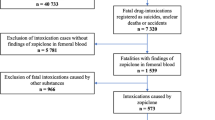Summary
In organophosphate intoxication the assessment of both the degree of severity of poisoning and the initial dose of pralidoxime and atropine are as yet based only on clinical symptoms.
We present three patients with clinically severe organophosphate poisoning in whom a prompt recovery from central nervous symptoms occurred after the administration of low doses of atropine and pralidoxime. It is suggested that the true severity of organophosphate intoxication as well as the initial therapy should be determined by the amount ingested, the propensity for aging, and the pharmacodynamic properties of the organophosphorus compound, as well as by the time interval between exposure and initiation of appropriate treatment, as far as these data can be verified in the individual patient.
Similar content being viewed by others
References
Edery H (1962) Effects of organophosphorus compounds, oximes and atropine injected into the third ventricle of unanesthetized dogs. Brit J Pharmacol 18:19–28
Erdmann WD, Sakai F, Scheler F (1958) Erfahrungen bei der spezifischen Behandlung einer E 605-Vergiftungen mit Atropin und dem Esteraseaktivator PAM. Deutsch Med Wochenschr 83:1359–1362
Longo VG, Nachmansohn D, Bovet D (1960) Aspects électroencéphalographiques de l'antagonisme entre le iodométhylate de 2-pyridine aldoxime (PAM) et le méthylfluorophosphate d'isopropyle (sarin). Arch Int Pharmacodyn 123:282–290
Namba T, Hiraki K (1958) PAM (pyridine-2-aldoxime methiodide) therapy for alkylphosphate poisoning. JAMA 166:1834–1839
Namba T, Nolte CT, Jackrel J, Grob D (1971) Poisoning due to organophosphate insecticides. Acute and chronic manifestations. Amer J Med 50:475–492
Schuchter A, Kawel HG, Schneider JA (1960) Kombinierte Behandlung einer Vergiftung durch Diäthyl-p-nitrophenylthiophosphate mit Pyridinaldoxim-(2)-methojodid und Atropin. Arzneimittelforschung 10:399–400
Senanayake N, Lakshman K (1987) Neurotoxic effects of organophosphorus insecticides. An intermediate syndrome. N Engl J Med 316:761–763
Tafuri J, Roberts J (1987) Organophosphate poisoning. Ann Emerg Med 16:193–202
Willems JL (1981) Poisoning by organophosphate insecticides: analysis of 53 human cases with regard to management and drug treatment. Acta Med Milit Belg 134/1:7–14
Author information
Authors and Affiliations
Rights and permissions
About this article
Cite this article
De Wilde, V., Vogelaers, D. & Colardyn, F. Prompt recovery from severe cholinesterase-inhibitor poisoning — Remarks on classification and therapy of organophosphate poisoning. Klin Wochenschr 68, 615–618 (1990). https://doi.org/10.1007/BF01660960
Received:
Accepted:
Issue Date:
DOI: https://doi.org/10.1007/BF01660960




